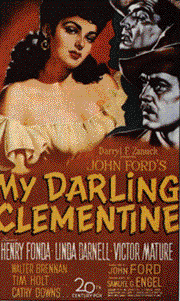The Western Narrative
Style
The western narrative may adopt any of several basic styles. The classic western was most common from the early silents starting with Cripple Creek Barroom (1898) through the 1950s, including My Darling Clementine. This style was optimistic, progressive, triumphant. This style was common to the B film serials of the the 1930s-1940s, including Hopalong Cassidy and the popular Roy Rogers and Gene Autry singing cowboy films. It was the style of the low-budget westerns of Budd Boetticher in the 1950s such as The Tall T with Randolph Scott, and is found today in the Russian film White Sun of the Desert (1970) and in the soon-to-be-released Texas Rangers and American Outlaws. The Semi-Classic western that emerged in the 1950s was less positive, more ambivalent about the progress and civilization. High Noon (1952) was about existential man alone in the era of McCarthy and the Korean War. The protagonist in Shane (1953) was heroic but could not fit in with others. John Ford's westerns show a progressive loss of faith in America, from The Searchers (1956) with its famous closing door ending, to The man Who Shot Liberty Valance (1962) and Cheyenne Autumn (1968). The Revisionist westerns that began in the 1960s featured increasing violence and chaos, with anti-hero central characters. This style was followed by the spaghetti westerns of Sergio Leone, and the films of Sam Peckinpah that dealt with aging heroes in Ride the High Country (1962) and a corrupt "wild" society that destroyed The Wild Bunch (1969) with his trademark sunset ending. Another kind of revisionism is the western parody that pokes fun and exaggerates the conventions of the style. Such parodies include The Sheepman (1958) with Glenn Ford and Shirley MacLaine and Leslie Nielsen; Blazing Saddles (1974) directed by Mel Brooks; Rustlers' Rhapsody (1985) with Tom Berenger.
Structure
The symmetrical structure of My Darling Clementine is arranged around a three-day period, with the gunfight as the climax resolving the tensions that started with the death of James and continued with the search for his killer. The simple structure is made rich and deep and complex by metaphors, themes, atmosphere, characterization and ritual scenes. The historical reality of the "Shootout at the O. K. Corral" is secondary to the narrative elements that create a powerful vision of America.
Themes
The basic theme of all westerns is nature vs civilization. The West from American history provided a primitive setting for characters to prove themselves, get rich, build towns, shoot outlaws, find love, start a family. John Ford used Monument Valley to provide the raw setting, simple, gentle, honest, rugged, like the men who came west and were shaped by the land. The half-built town has one side open to this wilderness, is in process of being developed. This development involves the themes of the individual vs the group, family as an extension of the individual, interior vs exterior space, social control and self-control, His film reflected America in 1946, emerging as a world empire, having defeated the enemy in WWII, confidant and supreme.
Characters
Wyatt is restrained with inwardly formed courage and unhurried self-confidence; Doc is emotional and impulsive and theatrical; Clementine is the good girl from the east; Chihuahua is the bad girl from the west; the Clantons are separate from the community and live in a a night world and speak in monosyllables.
Techniques
John Ford composed his films with ritual scenes such as the Sunday morning dance; he clusters figures together in suffering and rejoicing, avoiding individual closeups ; big soft closups used to emphasize the narcissism of Chihuahua but not for Clementine; sustained long shots for Wyatt's walking; symbols include the silver cross, barber pole, cactus, hat; the sagauro cactus and saloon and barber pole appear and disappear; gestures have meaning, such as dropping poker chips into hat, tossing the hat at the dance; cross-cutting used for the scene of Wyatt chasing Doc; montage used for the shootout.
revised 2/17/01 | Top Western Films | Film Genres Chart | My Darling Clementine| Filmnotes

